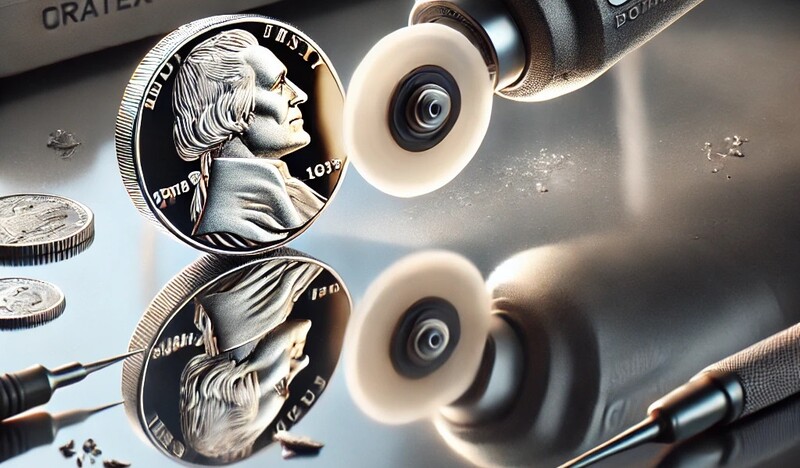Hobo Nickel: Pocket-Size American History | CRATEX Abrasives
This article is part of Hobo Nickel – Remarkable Coin Art series.
For full article click here
Due to the low price and fact that you can find just about anything engraved, hobo coins can be a pretty neat birthday present. However, there is a different side to these coins, as many of them represent a pocket-size piece of American history that you can always carry with you. Artists modify these small pieces of history coins by keeping their original concept, but by adding their own comments or turning them into history moments of another dimension.
Here are some of the most famous coins with that tell a few interesting stories.
Commemorating Peace – The Peace Dollar
The Peace Dollar was first produced in December 1921, the original purpose of the Peace Dollar was to commemorate the post-WWI peace. The idea about commemorating the peace came from Farran Zerbe, an active promoter of numismatics and once the president of the American Numismatic Association (ANA). The Commission of Fine Arts held a competition for the design of the new silver dollar and invited eight distinguish sculptors to take part. An Italian-American sculptor named Anthony DeFrancisci was the youngest participant who ended up winning the competition and taking home the $1,500 cash prize. DeFrancisci used his wife as the model to represent something American with an intention to capture the spirit of the country which was defined by the intellectual speed, vitality and vigor. The design ended up being his most famous one.
The front of the coin depicts the left profile of Miss Liberty wearing a diadem with spikes, quite similar as seen on the Statue of Liberty. The letters “LIBERTY” are above, and the date and “IN GOD WE TRUST” is below. The back side depicts an eagle perched on a rock that has a laurel branch sticking out and letters “PEACE” written on the stone. The sun rays can also be seen emerging from the bottom right, as the eagle proudly stands above them. Many argue that the Peace Dollar is the most beautiful coin ever produced.
Absolute Beauty – The Walking Liberty Half Dollar
Then there is the Walking Liberty Half Dollar. The design of the coin has been a favorite among the numismatists ever since it came out and it many consider it one of the most beautiful coin motifs of all time. The design of a Germany-born American sculptor named Adolph Alexander Weinman was chosen as the new motif of the half dollar in 1916.
The front of the coin depicts the Miss Liberty waking toward the sun or the dawn of the new day with her right arm outstretched. She’s carrying a bundle of laurel and oak branches in her left hand which represents civil and military glory. Her cape is flowing in the wind behind her. The letters “LIBERTY” are written above, with “IN GOD WE TRUST” on the lower right and the date below. The back side depicts an eagle with wings unfolded, perched on a rocky crag with a pine branch, the symbol of strength and America, growing from it. The eagle looks fearless and conscious of his power.
Morgan Dollar
Another sweet piece of American history is the Morgan Dollar, George T. Morgan’s creation that has become America’s most famous and most collected silver dollar. The reason lies in it beautiful design, 90% silver content, its size and high mintages (Philadelphia, San Francisco, Denver, New Orleans and Carson City).
The coin was minted from 1878 to 1904 and again in 1921 (replaced by the Peace Dollar) and was the first silver dollar minted since the previous Seated Liberty design which ceased after the Coinage Act of 1973 was passed. The act demonetarized silver, so in response to the difficult economic condition during the 1870s, the Congress passed the Bland-Alisson Act in 1878 that required the government to purchase large quantities of silver and start producing silver dollars. This way the dollar denomination was restored once again, and the Morgan Dollar was born.
As for the design, Morgan wanted to use an American woman to depict Liberty and not the usual imaginary Greek-style figure. His friend and artist Thomas Eakins suggested Anna Willes Williams as the model, a teacher and a philosophical writer from Philadelphia. Eakins knew her father and after introducing her to Morgan, he became so impressed with her profile that he noted that it’s the most perfect profile he had seen in both England and America. Although Miss Williams wanted to remain anonymous, her identity was discovered shortly after the dollar was released, so she had difficulties dealing with her being famous.
Read more about the nickel cherished the most among the hobo coin artists, the Buffalo or Indian Head Nickel, in the next chapter.
